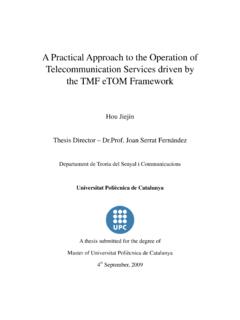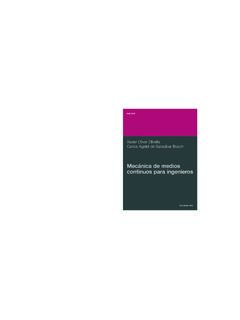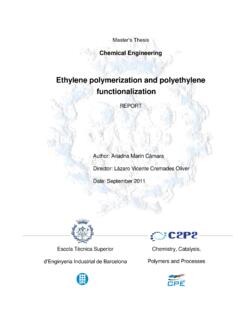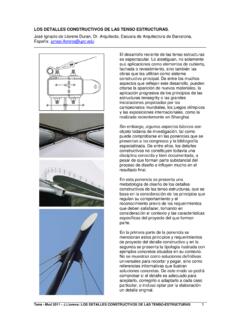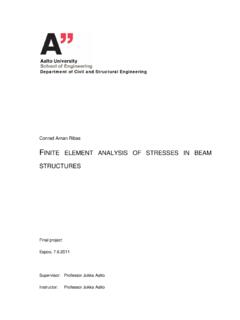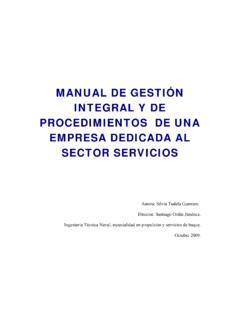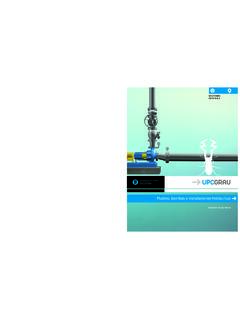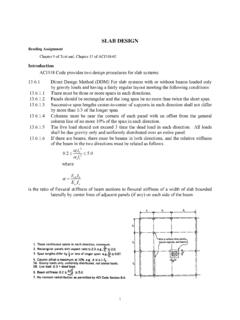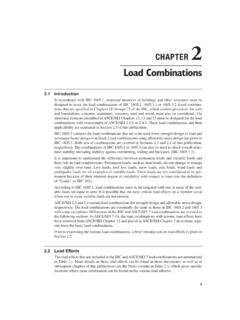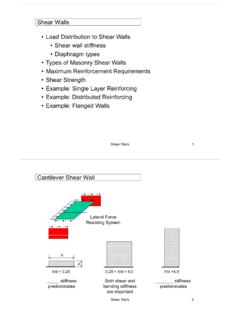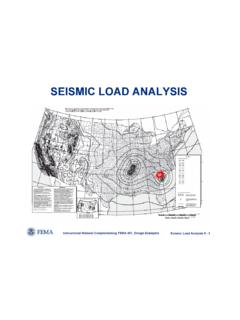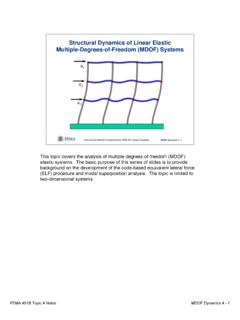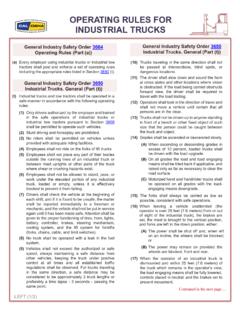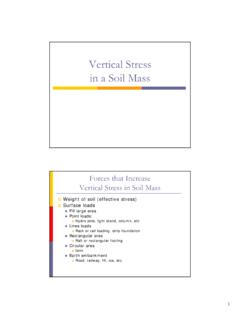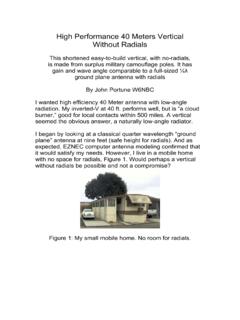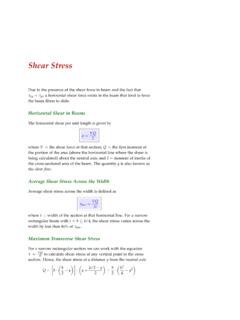Transcription of SMALL-SCALE VERTICAL AXIS WIND TURBINE DESIGN
1 SMALL-SCALE VERTICAL AXIS wind TURBINE DESIGN Javier Castillo Bachelor s Thesis December 2011 Degree program in Aeronautical Engineering Tampereen ammattikorkeakoulu Tampere University of Applied Sciences ABSTRACT Tampereen ammatikorkeakoulu Tampere University of Aplied Sciences Degree Programme in Aeronautical Engineering CASTILLO, JAVIER: SMALL-SCALE VERTICAL axis wind TURBINE DESIGN Bachelor s thesis 54 pages, appendixes 15 pages December 2011 The thesis focuses on the DESIGN of a small VERTICAL axis wind TURBINE rotor with solid wood as a construction material. The aerodynamic analysis is performed implementing a momentum based model on a mathematical computer pro-gram. A three bladed wind TURBINE is proposed as candidate for further prototype test-ing after evaluating the effect of several parameters in TURBINE efficiency, torque and acceleration.
2 The results obtained indicate that wood is a suitable material for rotor construc-tion and a further development of the computer algorithm is needed in order to improve the flow conditions simulation. Key words: wind TURBINE , giromill, VERTICAL axis, small wind TURBINE 3 Table of Contents 1 INTRODUCTION .. 5 2 PRELIMINARY BUSINESS PLAN .. 5 Product definition .. 6 Demand analysis .. 6 Demand projection .. 8 Offer analysis .. 8 3 wind TURBINE TYPES .. 11 Rotor axis orientation .. 11 Lift or Drag type .. 12 Power control .. 12 Rotor speed: constant or variable .. 13 Tower structure .. 14 4 AERODYNAMIC ANALYSIS .. 14 wind TURBINE DESIGN parameters .. 14 Blade performance initial estimations .. 18 Aerodynamic model.
3 19 Model limitations .. 28 Algorithm implementation .. 29 Algorithm validation .. 30 5. ROTOR DESIGN .. 33 Starting parameters .. 33 Airfoil selection .. 34 DESIGN airspeed .. 35 Rotor dimensions .. 37 Solidity .. 39 Initial angle of attack .. 42 6. ACCELERATION ANALYSIS .. 43 7. STRUCTURAL ANALYSIS .. 45 Rotor configuration .. 45 Allowable stress and selected materials .. 46 Load analysis .. 49 8. FINAL DESIGN AND OPERATION .. 49 9. CONCLUSIONS .. 52 10. BIBLIOGRAPHY .. 53 4 APPENDIXES .. 55 SYMBOLS .. 55 56 WORLD ENERGY TRENDS .. 57 COMPETENCE ANALYSIS .. 58 MATLAB ALGORITHM .. 60 NACA0021 AIRFOIL DIMENSIONS .. 67 WOOD PROPERTIES AND STRUCTURAL STRENGTHS .. 68 5 1 INTRODUCTION wind power energy is getting more shares in the total energy production every year, with wind turbines growing bigger and bigger at the rhythm of technology does.
4 While we cannot expect nowadays a totally renewal energy supply in Europe, (some estimations say that it is possible for 2030) there are places where ener-gy grid has not even arrived and has not any plans for short or midterm time. As we charge our mobile phone in any socket, there are people that has to illu-minate their homes with kerosene lamps, students that cannot study when the daylight extinct, medicines that cannot be stored in a There are other people that are connected to the grid but still have energy cuts. For these people, it seems to be cheaper to have a grid connection than to have an independent energy source, reasons for that are that in an isolated installa-tion the energy has to be chemically stored in batteries, with limited lifetime that makes renewal costs comparable to those of a grid connection.
5 Furthermore, there are places which will not have electricity access, these plac-es coincide with the poorest and isolated rural areas of developing countries, and these people cannot afford the cost of a wind TURBINE , nor small nor bigger. Maybe a free TURBINE DESIGN , that anyone with common workshop materials could build, would make a difference in the living conditions of this people. The purpose of this project is to provide an alternative to these people. 2 PRELIMINARY BUSINESS PLAN A preliminary analysis of the situation of wind turbines used for similar applica-tions is done analyzing the current manufacturers and market situation. 6 Product definition The product is a VERTICAL axis SMALL-SCALE wind TURBINE , corresponding to the mi-cro-generation classification of wind turbines, which is less than 1 kW.
6 The aim of the project is to make an affordable TURBINE , made locally with available mate-rials in developing countries. There are two different poles in micro-generation markets: - On one hand we have manufacturers that had invested in a certification program, use ultimate technologies ( electronic controllers or carbon fiber blades) and have a product oriented to developed country consum-er. - On the other hand there are some non-governmental organizations or in-dividuals that build a model from wood, they also construct the generator, but there is no certification process. The product is intended to be somewhere in the middle of this situation, having raw materials like wood and without a very sophisticated construction process, the idea is to make it constructible with usual and non electrically driven work-shop tools.
7 The IEC 61400 wind TURBINE generator systems standards are the reference used for the certification of wind turbines. The IEC61400-2 focuses in DESIGN requirements for small wind turbines but they are not applicable to VERTICAL -axis wind turbines (Wood, 2011). Technical standards should be considered in the DESIGN in order to ensure safe-ty, reliability and durability of the wind TURBINE , but standards for VERTICAL -axis wind turbines have not been developed and a complete certification should be done by accredited institutions, which is expensive (Cace, et al., 2007). Demand analysis billion People, 80% of them living in Sub-Saharan Africa and South Asia, do not have access to electricity.
8 This population uses kerosene and batteries for 7 their households and diesel generators for their businesses (Legros, Havet, Bruce, & Bonjour, 2009). Access to energy closely correlates with poverty: insufficient access to electrici-ty or other energy sources also means that health services, access to clean wa-ter and sanitation, and education all suffer (Cheikhrouhou, 2011). With scarcity of resources, efforts on grid extension are focused to serve large population cities while rural remote areas are considered to have too much electrification costs to serve few people. According to (winafrique, 2011): - A small wind TURBINE production facility will cost less than a photovoltaic factory of the same capacity.
9 - wind turbines are very difficult to develop but not to manufacture. - Local manufacturing, under license or through a joint venture, is neces-sary if widespread utilization is to be pursued. A small wind TURBINE DESIGN with very low regular maintenance, available spare parts and with local users trained could meet the requirements needed for a long operation in developing countries. The following figure shows the geographical distribution of the areas that could need the product. Figure 1. Energy access percentage in developing countries (Legros, Havet, Bruce, & Bonjour, 2009) 8 Demand projection Developing countries have potential demand for small wind systems because they normally do not have electricity grid in rural areas.
10 People need financial assistance to buy small wind systems but government assistance is directed nowadays to subsidizing extension of the grid and installing diesel generators (American wind Energy Association, 2002). World electricity generating capacity is projected to increase a 46 percent by 2035, being the non-OECD countries the ones with a major contribution in total capacity increase (71%). The figures on appendix 2, made with extracted data from ( Energy Information Administration, 2011), show the projected in-crease in wind -powered installed generating capacity by 2035, which will be 2,75 times the actual generating capacity and will represent a in the world total generating capacity (nowadays represents the 3,95%).
